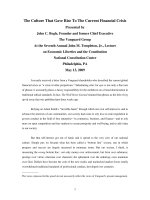The New Brazilian Cinema ppt
Bạn đang xem bản rút gọn của tài liệu. Xem và tải ngay bản đầy đủ của tài liệu tại đây (6.91 MB, 325 trang )
The New Brazilian Cinema
Edited by
Lúcia Nagib
in association with
The Centre for Brazilian Studies, University of Oxford
The New Brazilian Cinema
Published in 2003 by I.B. Tauris & Co Ltd
6 Salem Road, London W2 4BU
175 Fifth Avenue, New York NY 10010
www.ibtauris.com
in association with The Centre for Brazilian Studies, University of Oxford
www.brazil.ox.ac.uk
In the United States of America and Canada distributed by
Palgrave Macmillan a division of St. Martin’s Press
175 Fifth Avenue, New York NY 10010
Copyright © The Centre for Brazilian Studies, University of Oxford, 2003
All rights reserved. Except for brief quotations in a review, this book, or
any part thereof, may not be reproduced, stored in or introduced into a
retrieval system, or transmitted, in any form or by any means, electronic,
mechanical, photocopying, recording or otherwise, without the prior
written permission of the publisher.
ISBN 1 86064 928 9 paperback
1 86064 878 9 hardback
A full CIP record for this book is available from the British Library
A full CIP record is available from the Library of Congress
Library of Congress Catalog Card Number: available
Text prepared by the author as CRC
Typeset in New Baskerville by Luciana Cury, São Paulo, Brazil
Printed and bound in Great Britain by MPG Books Ltd, Bodmin
Copy editing: Neil Hancox and Stephen Shennan
Translation: Tom Burns, Stephanie Dennison, Vladimir Freire, Lúcia Nagib,
Lisa Shaw and Roderick Steel.
List of illustrations
Notes on contributors
Foreword
Introduction
Acknowledgements
Part one: Producing films in Brazil
1 A new policy for Brazilian Cinema
JOSÉ ÁLVARO MOISÉS
2 The cinema that Brazil deserves
CARLOS DIEGUES
Part two: Fiction film and social change
3 Brazilian Cinema in the 1990s: the unexpected
encounter and the resentful character
ISMAIL XAVIER
4 Humility, guilt and narcissism turned inside out in
Brazil’s film revival
FERNÃO PESSOA RAMOS
5 C h ronically Unfeasible: the political film in a
depoliticized world
JOÃO LUIZ VIEIRA
viii
xi
xv
xvii
xxvii
3
23
39
65
85
Contents
Part three: Documenting a country
6 It’s all Brazil
AMIR LABAKI
7 A cinema of conversation – Eduardo Coutinho’s
Santo Forte and Babilônia 2000
VERÔNICA FERREIRA DIAS
Part four: Sertão and favela: the eternal return
8 The sertão and the favela in contemporary
Brazilian film
IVANA BENTES
9 The sertão in the Brazilian imaginary at the end of
the millennium
LUIZ ZANIN ORICCHIO
10 Death on the beach – the recycled utopia of
Midnight
LÚCIA NAGIB
Part five: Screen adaptations
11 Nelson Rodrigues in the 1990s: two recent
screen adaptations
STEPHANIE DENNISON
12 An oblique gaze: irony and humour in Helvécio
Ratton’s Love & Co
MARIA ESTHER MACIEL
Part six: History and film history
13 Cabral and the Indians: filmic representations of
Brazil’s 500 years
ROBERT STAM
97
105
121
139
157
175
193
205
14 For all and traditions of popular musical comedy
LISA SHAW
15 ImagiNation
JOSÉ CARLOS AVELLAR
Part seven: Epilogue
16 Then and now: cinema as history in the light of
new media and new technologies
LAURA MULVEY
Index
229
245
261
271
List of illustrations
1 Dalva (Alleyona Cavalli) and Vítor
(Paulo Vespúcio Garcia) in Um céu de estrelas
2 Branquinha (Priscila Assum) and Japa
(Sílvio Guindane) in Como nascem os anjos
3 Alex (Fernanda Torres) and Paco
(Fernando Alves Pinto) in Terra estrangeira
4 Júlia Lemmertz and Alexandre Borges in
Um copo de cólera
5 Dora (Fernanda Montenegro) and Josué
(Vinícius de Oliveira) in Central do Brasil
6 Michael Coleman (Henry Czerny) in Jenipapo
7 Andréa/Maria (Fernanda Torres) and Charles
Elbrick (Alan Arkin) in O que é isso, companheiro?
8 Carlota Joaquina (Marieta Severo) in
Carlota Joaquina – princesa do Brasil
9 Maria Alice (Betty Gofman) in
Cronicamente inviável
10 Luiz Carlos Prestes in O velho
11 Terra do mar
12 Eduardo Coutinho in Babilônia 2000
43
45
51
57
61
75
76
77
87
101
103
107
13 Teresa in Santo forte
14 A popular festival in Crede-mi
15 Patrícia França and Toni Garrido in Orfeu
16 Maria Emilce Pinto in Sertão das memórias
17 Lampião (Luís Carlos Vasconcelos) and
Maria Bonita (Zuleica Ferreira) in
Baile perfumado
18 João (Luís Carlos Vasconcelos) and a jailer
(Tonico Pereira) in O primeiro dia
19 Maria (Fernanda Torres) in O primeiro dia
20 Alicinha (Ludmila Dayer) in ‘Diabólica’,
an episode of Traição
21 Alves (Marco Nanini) and Ludovina
(Patrícia Pillar) in Amor & Cia.
22 Silvino Santos in O cineasta da selva
23 Yndio do Brasil
24 For all
25 Alva (Sonja Saurin), Ninhinha (Barbara Brandt)
and Liojorge (Ilya São Paulo) in A terceira margem
do rio
111
129
131
145
149
159
169
183
195
223
225
235
249
ix
JOSÉ CARLOS AVELLAR was the president of Riofilme, the film
distribution company of Rio de Janeiro, during the first years of
the revival of Brazilian film production (1993-00). He is currently
the director of Martim 21, a distribution company of Brazilian and
Latin-American films, and the coordinator of the Programa
Petrobras Cinema, that funds films and other activities related to
cinema. He is a film critic and film historian, and the author,
among other books, of Cinema dilacerado (Rio de Janeiro, 1986)
and A ponte clandestina (Rio de Janeiro/São Paulo, 1995).
IVANA BENTES is a film and visual arts researcher and critic. She
is Associate Professor of Audio-visual Language, History and
Theory at the School of Communication of the Federal University
of Rio de Janeiro (UFRJ) and an associate researcher at the
Advanced Programme of Contemporary Culture (PACC) of UFRJ.
She is the author of the book Joaquim Pedro de Andrade: a revolução
intimista (Rio de Janeiro, 1996) and the editor of Cartas ao mundo:
Glauber Rocha (São Paulo, 1997). She is the co-editor of the jour-
nal Cinemais: revista de cinema e outras questões audiovisuais.
STEPHANIE DENNISON teaches Brazilian Culture and Cinema
at the University of Leeds, UK, where she also directs an MA pro-
gramme in World Cinema. She has published articles on Brazilian
Cinema, and, among other projects, she is currently co-writing a
book on commercially successful Brazilian films (forthcoming
with Manchester University Press).
VERÔNICA FERREIRA DIAS is a filmmaker with a Master’s
degree in Communication and Semiotics from the Catholic
University of São Paulo, with a dissertation on Eduardo Coutinho.
Notes on contributors
THE NEW BRAZILIAN CINEMAxii
She has taught Theory of Communication and Educational
Technology: TV/VT at the Faculdade Associada de Cotia, Brazil.
CARLOS DIEGUES is one of the best-known Brazilian filmmak-
ers. He started filming during the Cinema Novo in the 1960s, with
Ganga Zumba (1964), and has so far directed 15 feature films,
among them A grande cidade (The Big City, 1966), Xica da Silva
(1976), Bye bye Brasil (1980), Quilombo (1984), Tieta (Tieta of Agreste,
1996) and Orfeu (1999).
AMIR L A B A K I is the leading film critic of the daily newspaper
Folha de S. Paulo and a columnist of the newspaper Valor Econômico.
He is the founder and director of It’s All True – The International
D o c u m e n t a ry Film Festival (São Paulo and Rio de Janeiro). He is
the author, among others, of the book O olho da revolução – o cine-
ma-urgente de Santiago Alvare z (São Paulo, 1994) and the editor,
among others, of O cinema brasileiro/The Films from Brazil (São Paulo,
1998) and Person por Person (São Paulo, 2002). He is a former direc-
tor of the Museum of Image and Sound, São Paulo (1993-95).
MARIA ESTHER M A C I E L is Associate Professor of Literary
Theory and Comparative Literature at the Federal University of
Minas Gerais, Brazil. Her books include As vertigens da lucidez: poe-
sia e crítica em Octavio Paz (São Paulo, 1995), A palavra Inquieta:
homenagem a Octavio Paz (Belo Horizonte, 1999) and Vôo transver-
so: poesia, modernidade e fim do século XX (Rio de Janeiro, 1999). She
is the co-editor of Borges em dez textos (Rio de Janeiro, 1998). She is
currently working on literature and cinema, carrying out research
on Peter Greenaway.
JOSÉ ÁLVARO MOISÉS was the National Secretary of Cultural
Support (1995-98) and the National Secretary for Audio-visual
Affairs (1999-02) at the Ministry of Culture, Brazil. He is Associate
Professor of Political Science at the University of São Paulo and
was a Visiting Fellow at St Antony’s College, Oxford (1991-92). He
is the author of several books, including Os brasileiros e a democra-
cia (São Paulo, 1995).
LAURA MULVEY is Professor of Film and Media Studies at
Birkbeck College, University of London. She has been writing
about film and film theory since the mid-1970s. Her books include
Visual and Other Pleasures (London, 1989) and Fetishism and
Curiosity (London, 1996). In the late 1970s and early 80s, she co-
directed six films with Peter Wollen including Riddles of the Sphinx
(BFI, 1978) and Frida Kahlo and Tina Modotti (Arts Council, 1980).
In 1994 she co-directed the documentary Disgraced Monuments with
artist/filmmaker Mark Lewis.
LÚCIA NAGIB is Associate Professor of Film Studies at the State
University of Campinas and the director of the Centre for Cinema
Studies at the Catholic University of São Paulo. She is a film and
art critic of the daily newspaper Folha de S. Paulo. Her books
include Werner Herzog, o cinema como realidade (São Paulo, 1991),
Em torno da nouvelle vague japonesa (Campinas, 1994), Nascido das
cinzas – autor e sujeito nos filmes de Oshima (São Paulo, 1995) and O
cinema da retomada – depoimentos de 90 cineastas dos anos 90 (São
Paulo, 2002). She is currently a Leverhulme Trust Visiting
Professor at Birkbeck College, University of London.
LUIZ ZANIN ORICCHIO is the leading film critic of the daily
newspaper O Estado de S. Paulo, where he is also the chief editor of
the Cultura supplement. He is currently working on a book on
contemporary Brazilian cinema.
FERNÃO PESSOA RAMOS is Associate Professor of Film Studies
at the State University of Campinas, Brazil. He is the author of
Cinema marginal – a representação em seu limite (São Paulo, 1987) and
the editor of História do cinema brasileiro (São Paulo, 1988)and
Enciclopédia do cinema brasileiro (São Paulo, 2000). He directs the
series ‘Campo imagético’ for Papirus Press, Campinas. In 2002 he
was a Visiting Professor at the University of Paris III/Sorbonne
Nouvelle. He is a former president of SOCINE (Brazilian Society
for Cinema Studies).
LISA SHAW is the author of The Social History of the Brazilian Samba
(Ashgate, 1999) and numerous articles on Brazilian popular cine-
ma (1930-60) and the evolution of popular music in Brazil in the
1930s and 1940s. She is Senior Lecturer in Portuguese at the
University of Leeds, UK. In the autumn term of 1999 she was
Visiting Associate Professor in the Department of Spanish and
Portuguese at the University of California, Los Angeles.
NOTES ON CONTRIBUTORS
xiii
THE NEW BRAZILIAN CINEMAxiv
ROBERT STAM is University Professor at the New York Universi-
ty. He is the author of many books, among them: Tropical Multicul-
turalism: A Comparative History of Race in Brazilian Cinema & Culture
( D u rham/London, 1997) and Film Theory – An Intro d u c t i o n
(Oxford, 2000). His recent publications include three books on
literature and cinema: Literature and Film: Realism, Magic and the
Art of Adaptation (Oxford, 2003), Literature and Film: A Reader (with
A. Raengo, Oxford, 2003) and A Companion to Film and Literature
(with A. Raengo, 2003). He is the editor, with Randal Johnson, of
Brazilian Cinema (New York, 1995).
JOÃO LUIZ VIEIRA is Associate Professor of Film Language and
Theory at the Universidade Federal Fluminense, Niterói, Brazil.
He contributed to the edited collection Brazilian Cinema (Randal
Johnson and Robert Stam, eds, New York, 1995) and has
authored, among others, Glauber por Glauber (Rio de Janeiro,
1985), A Construção do Futuro: mais um século de cinema (Rio de
Janeiro, 1995), as well as co-authoring D.W.Griffith and the Biograph
Company (New York, 1985) and Cinema Novo and Beyond, an accom-
panying volume to the major retrospective of Brazilian cinema
organized by MoMA, New York, in 1999.
ISMAIL XAVIER is Professor at the Department of Film and
Television, University of São Paulo. He has been a visiting scholar
at the New York University (1995), the University of Iowa (1998)
and the University of Paris III/Sorbonne Nouvelle (1999).
His books include Sertão mar – Glauber Rocha e a estética da fome
(Rio de Janeiro/São Paulo, 1983), O discurso cinematográfico (Rio
de Janeiro/São Paulo, 1984) and Alegorias do subdesenvolvimento
(São Paulo, 1993), which has been published in English
as Allegories of Underdevelopment: Aesthetics and Politics in Modern
Brazilian Cinema (Minneapolis/London, 1997).
T
he Centre for Brazilian Studies, established in 1997, is a
University of Oxford centre of advanced study and research.
One of its principal aims is to promote a greater knowledge and
understanding of Brazil – its history, society, politics, economy, eco-
logy and, not least, its culture – through a programme of research
projects, seminars, workshops, conferences and publications. The
Centre publishes research papers and working papers, and recently
published its first work of reference: a guide to the manuscript
collections relating to Brazil in British and Irish archives, libraries
and museums. The New Brazilian Cinema is the Centre’s first mono-
graph – published in association with I.B.Tauris.
Brazilian film making goes back to the end of the nineteenth
c e n t u ry and has had periods of considerable achievement. But after
the great days of Cinema Novo in the 1960s and the commercially
successful productions of Embrafilme (the Brazilian Film
Company) in the 70s and early 80s, the Brazilian film industry
entered a period of decline and in the early 1990s totally collapsed
o r, to be more precise, was dismantled. This book brings together
an outstanding collection of essays by film scholars, film critics and
filmmakers, mostly Brazilian but also from the United States and
the UK, to provide the first comprehensive and critical review of the
remarkable renaissance of Brazilian Cinema, both feature length
fictional films and documentary films, since 1994. It will be of great
interest and value to students of cinema and cinema enthusiasts not
only in Brazil but also in the UK, the USA and elsewhere.
The volume has its origins in a conference on contemporary
Brazilian Cinema organized by the Centre for Brazilian Studies
and held at Wadham College, Oxford in June 2000. At the same
time the Centre organized a Brazilian Film Festival under the title
‘From Cinema Novo to the New Cinema’ at the Phoenix Cinema
and Magdalen College, Oxford. The conference and the festival
Foreword
THE NEW BRAZILIAN CINEMAxvi
were coordinated by Dr Lúcia Nagib, Associate Professor in film
history and theory at the State University of Campinas, who was a
Ministry of Culture Research Fellow at the Centre in 2000. Dr
Nagib has now edited this volume.
I am grateful to the Brazilian Ministry of Culture, and espe-
cially Minister Francisco Weffort and Dr José Álvaro Moisés,
National Audio-visual Secretary (and a contributor to the vol-
ume), for generously providing funding for the conference, the
festival and the publication of this book. Additional financial sup-
port was provided by the Brazilian Embassy in London and the
Fundação Armando Álvares Penteado in São Paulo.
Leslie Bethell
Director,
Centre for Brazilian Studies,
University of Oxford
T
his book presents the first comprehensive critical survey of
contemporary Brazilian Cinema to both a Brazilian and an
international readership. The period in focus begins in the mid
1990s, when a new Audio-visual Law, promulgated in 1993, started
to yield its first results, prompting a boom in film production that
became known as the retomada do cinema brasileiro, or the ‘rebirth
of Brazilian Cinema’.
This cinematic ‘renaissance’ occurred at an emblematic
moment of democratic consolidation in the country. Before it,
Brazil had gone through decades of traumas: twenty years of mili-
tary dictatorship, the illness and death of appointed President
Tancredo Neves on the verge of taking office, President Sarney’s
inflationary years and, finally, the obscurantist disaster of the first
President democratically elected after the dictatorship, Fernando
Collor de Mello, who took office in 1990 and was impeached for
corruption less than two years later, in 1992.
The first two years of the 1990s were certainly among the worst
in Brazilian film history. As soon as he was in power, Collor down-
graded the Ministry of Culture to a Secretariat and closed down
several cultural institutions, including Embrafilme (the Brazilian
Film Company), which was already in difficulties but still
remained the main support for Brazilian Cinema. In 1992, only
two long feature films were released in Brazil. The cinematic
revival began during President Itamar Franco’s mandate, which
completed Collor’s term, and was developed during Fernando
Henrique Cardoso’s two terms as President (1995-02).
The Franco government’s first measure to foster film produc-
tion was the creation of the Brazilian Cinema Rescue Award
(Prêmio Resgate do Cinema Brasileiro), which re-allocated the assets
of Embrafilme. In three selections carried out between 1993 and
Introduction
1994, the Rescue Award was given to a total of ninety projects (25
short, nine medium and 56 full length films), which were com-
pleted in quick succession. Thus the bottleneck created by the two
years of Collor’s government resulted in an accumulation of films
produced in the following years. The Rescue Award was followed
by the passing of Law no 8685, known as the Audio-visual Law,
which adapted pre-existing laws of fiscal incentives to audio-visual
projects, thus boosting film production rates.
In six years, from 1994 through 2000, Brazil produced nearly
200 feature-length films, a remarkable figure considering that the
whole film industry in the country had been dismantled just prior
to that. Moreover, despite the serious problems of film distribu-
tion and exhibition, several of the films received an immediate
and enthusiastic response from critics and audiences. The first
clear sign that the Brazilian cinematic landscape was changing was
Carlota Joaquina – princesa do Brasil (Carlota Joaquina – Princess of
B r a z i l, Carla Camurati, 1995), which, even though initially
released only in alternative venues, soon attracted over one mil-
lion viewers.
In 1998, Central do Brasil (Central Station, Walter Salles) received
the Golden Bear in Berlin, and its leading actress, Fernanda
Montenegro, received the best actress award in the same festival.
Central do Brasil achieved enormous success in Brazil, launching
the country back on the international scene after an absence that
had lasted since the glorious days of Cinema Novo in the 1960s. The
film received a long list of awards in Brazil and abroad, including
the British Academy Film Award for best foreign film and Oscar
nominations for best foreign film and best actress. Its commercial
career abroad has also been very successful.
Apart from Central do Brasil, many other recent Brazilian films
– such as O que é isso, companheiro? (Four Days in September, Bruno
Barreto, 1997), Orfeu (Carlos Diegues, 1999) and Eu, tu, eles (Me
You Them, Andrucha Waddington, 2000) – were released world-
wide, starting a new market trend set in a wider frame of Latin-
American film revivals in the 1990s, which includes Argentina and
Mexico as well as Brazil. At the beginning of the Brazilian film
revival variety seemed to predominate. Directors ranged from vet-
erans to beginners, resuming old projects or searching for new
ideas. Styles moved from the openly commercial to the strictly
experimental, in fiction, documentary or mixed films. But after
nearly a decade, it is now possible to assert that most of the recent
THE NEW BRAZILIAN CINEMAxviii
films maintain a strong historical link with Brazilian films of the
past and that they share a number of features and tendencies. The
aim of this book is to shed a critical light on these new tendencies
and historical links.
In June 2000, experts from Brazil and the UK gathered at a
conference on contemporary Brazilian Cinema, called ‘Brazilian
Cinema: roots of the present, perspectives for the future’, held in
Oxford, under my coordination. The conference, accompanied
by a Brazilian film retrospective, was sponsored by the Centre for
Brazilian Studies, University of Oxford, and the Brazilian Ministry
of Culture, in connection with the commemorations of the 500
th
anniversary of Brazil’s discovery by the Portuguese. Several of the
chapters of this book originated from papers presented then; the
other chapters were commissioned in an effort to cover all the rel-
evant topics.
Contributors include filmmakers, cultural administrators, film
scholars and journalists. Some of them, such as filmmaker Carlos
Diegues, the former Audio-visual secretary José Álvaro Moisés and
the former director of Riofilme José Carlos Avellar, have partici-
pated directly in the Brazilian film revival. All the others, includ-
ing the American and British specialists, possess a long-standing
intimacy with Brazilian film history. Authors had total freedom to
express their minds, which has resulted in contrasting, often
opposing points of view on the same subject. This was not done to
generate polemic for its own sake, but to guarantee a space for the
variety of readings a film, a movement or a filmmaker can arouse.
The engagement apparent in the expression of these different
minds also shows how thought-provoking and inspiring new
Brazilian Cinema has become.
The consequences of the dismantling process
Part one of this collection deals with film production in Brazil
from the mid-1990s onwards. The opening chapter is a detailed
account of the so-called ‘rebirth of Brazilian Cinema’ by José
Álvaro Moisés. As a former National Secretary of Cultural Support
(1995-98) and National Secretary for Audio-visual Affairs (1999-02)
at the Ministry of Culture, Moisés was in a privileged position to
describe and analyse the political context behind the cinematic
boom, as well as the genesis of the Audio-visual Law, its flaws,
advantages and results. Having introduced the film revival, Moisés
goes on to present a retrospective account of the dismantling
INTRODUCTION xix
process during the short-lived Collor government. He then
explains how the Audio-visual Law led to investments reaching
R$ 450 million in the production of 155 feature films between
1995 and 2000. He does not fail to recognize the limits of the law,
which, despite its power to boost production, was unable to stim-
ulate the commercialization of the films produced. He also points
out problems, such as the excessively open selection system that
put experienced directors on the same level as beginners, and the
brokers’ outrageous fees for fund-raising, which go against the
public interest. According to Moisés, these and other problems
have been dealt with through more recent legislation and meas-
ures. In his conclusion, he supports the continuation of the Audio-
visual Law (originally due to expire in 2003), once it has been sub-
jected to the necessary amendments and updating.
In the next chapter, Carlos Diegues’ view of the same subject is
less optimistic. According to this experienced film director, who
was among the founders of Cinema Novo, none of the cycles or
periods of cinematic renaissance have managed to establish a
definitive film industry in Brazil, and the recent one is also
doomed to failure if urgent action is not taken. Diegues believes
that the main obstacle to the development of cinema in Brazil lies
not in the production but in the distribution of films. If this issue
is not properly looked at, he argues, ‘at best, the Audio-visual Law
can only create the biggest industry in the world of unreleased
films.’ Other problems affecting cinema in Brazil are, according to
him, declining audiences due to economic recession; the lack of
ancillary markets; the absence of the State as a mediator and reg-
ulator in the film market; and the absence of television from film
production and distribution. Diegues concludes by presenting a
long list of suggestions aimed at dealing with all these issues.
Part two looks at recent fiction films as an expression of social
phenomena. In his chapter, Ismail Xavier, the author of landmark
books on the Cinema Novo and modern Brazilian Cinema, starts by
drawing a comparison between the national project that animated
cinema in the 1960s and the return of national concerns in the
1990s, in films such as Como nascem os anjos (How Angels Are Born,
Murilo Salles, 1996), Baile perfumado (Perfumed Ball, Paulo Caldas
and Lírio Ferreira, 1997), Central do Brasil, Orfeu (Carlos Diegues,
1999) and C ronicamente inviável (C h ronically Unfeasible, Sérgio
Bianchi, 1999). In Xavier’s view, if the question of national identi-
ty remains a vital force in current films, there are also significant
THE NEW BRAZILIAN CINEMAxx
differences as the focus shifts from social teleology to individual
psychology, from the oppression of the State to that of organized
crime, from the social bandit to the cynical criminal, from revolu-
tionary romanticism to pop culture. His analysis leads to the for-
mulation of what he considers the main motifs of Brazilian
Cinema in the 1990s: the ‘unexpected personal encounter’, relat-
ed to different forms of migration, and the ‘resentful character’,
related to a sense of personal failure. As regards the former,
Xavier explains that ‘Brazilian films reveal their connection with
the contemporary state of sensibility, showing their concern for
the human aspects of the compression of space and time inherent
in the world of high technology.’ Concerning the latter, he points
out the ‘discomfort shared by a large group of characters who
have their minds set in the past and are obsessed by long-lasting
plans of revenge.’ Xavier goes as far as to see resentment ‘as a
national diagnosis’, a feeling that grows from the lack of political
hopes. He concludes by perceiving, in films such as Central do
B r a s i l , a ‘figure of redemption’ represented by the child,
described as a ‘moral reservoir that can still generate compassion.’
Approaching many of the films sympathetically analysed by
Xavier, Fernão Ramos, in his chapter, adopts a much harder criti-
cal position. His goal is to detect a ‘bad conscience’ caused by rep-
resentations of Brazil’s poor, ‘who are lending their voice to the
middle class filmmaker.’ According to Ramos, ‘in many films pro-
duced during the revival one can feel this bad conscience shifting
away from issues of social fracture to accusations directed at the
nation as a whole.’ He then proceeds to describe foreign (often
Anglo-Saxon) characters that appear in these films as a means ‘to
provide a point of comparison to the configuration of low self-
esteem, to measures of national incompetence.’ In his view,
Cronicamente inviável, with its bitter criticism of the ‘unviable
nation’, is the ultimate expression of a mechanism meant to pro-
vide a ‘comfortable viewing stance’, when the spectator, together
with the filmmaker, is placed outside the ‘ignoble universe’ pre-
sented in the film.
The final chapter in this part of the book provides a complete-
ly different view of Cronicamente inviável. João Luiz Vieira’s detailed
analysis of the film tries to show that it keeps alive the possibility
of radical social transformation through self-reflexive techniques
that refuse authority even to the voice-over commentator, with
whom audiences usually identify. In Vieira’s view, Cronicamente
INTRODUCTION xxi
inviável is a ‘political film in a depoliticized world’, that breaks
boundaries between documentary and fiction genres, defies con-
formism and ‘posits a thematic and stylistic agenda of resistance to
the oppressive and exploitative functioning of local and transna-
tional capitalism.’
Part three focuses on the documentary, a growing genre in
contemporary Brazilian Cinema. Amir Labaki, the director of the
São Paulo and Rio International Documentary Film Festival, gives
a broad panorama of recent production, connecting it with the
documentary tradition in Brazil since the pioneers. In the recent
revival, documentary production increased at the same time as
boundaries between documentary and fiction genres became
fluid. Thus he includes in his overview films that contain both fic-
tional and documentary material, such as O cineasta da selva (The
Filmmaker of the Amazon, Aurélio Michiles, 1997), Perfumed Ball and
Milagre em Juazeiro (Miracle at Juazeiro, Wolney de Oliveira, 1999).
As the author points out, documentaries have been at the root of
several fiction films of the revival. For example, Socorro Nobre
(Walter Salles, 1996) was a kind of prologue to Central do Brasil,
and Notícias de uma guerra particular (News of a Private War, João
Moreira Salles and Kátia Lund, 1998) is behind O primeiro dia
(Midnight, Walter Salles and Daniela Thomas, 1999).
Among those entirely devoted to non-fiction film is veteran
filmmaker Eduardo Coutinho, to whom a chapter is dedicated by
Verônica Ferreira Dias. Not only are his documentaries on Rio
favelas (shanty towns) and popular religion among the best of the
revival, but Dias embraces the idea, already suggested by Jean-
Claude Bernardet in the 1980s, that Coutinho is the greatest doc-
umentary filmmaker alive in Brazil. This is due, according to the
author, to his realist method, which reveals the mechanisms of
film production and denounces it ‘as a discourse, not a copy or
mirror of reality’.
Part four explores the most frequently recurring locations in
the films of the revival: the sertão (the arid backlands) and the
favela. That these had been favourite locations of Brazilian cinema
since the time of Cinema Novo makes comparison between these
two historical moments unavoidable. This is indeed the core of
Ivana Bentes’ chapter, which draws a parallel between recent sertão
and favela films and their predecessors. According to Bentes, ‘the
sertão and the favelas have always been the “other side” of modern
and positivist Brazil.’ However, what in the 1960s originated an
THE NEW BRAZILIAN CINEMAxxii
‘aesthetics of hunger’ (the title of Glauber Rocha’s famous 1965
manifesto) has now been turned into a ‘cosmetics of hunger’. It is
the shift from the ‘camera-in-hand and idea-in-mind’ (as a Cinema
Novo slogan used to go) to the steadicam, ‘a camera that surfs on
reality, a narrative that values the beauty and the good quality of
the image, and is often dominated by conventional techniques
and narratives.’ One of the main targets of her critique is the
acclaimed Central do Brasil, a film that is rescued by an entirely dif-
ferent approach in the next chapter, on the sertão in the Brazilian
imaginary, by Luiz Zanin Oricchio.
Oricchio’s chapter is especially appealing to non-Brazilian
readers, for it contains a detailed explanation of how the sertão
came to be such a privileged location in Brazilian cinema from the
beginning. His account starts with the Rebellion of Canudos, at
the end of the nineteenth century, in the backlands of Bahia state,
and the extraordinary report on the several battles written by
Euclides da Cunha in the classic book Os sertões (Rebellion in the
Backlands). After analysing the developmentalism and the revolu-
tionary hopes that animated films in the 1960s drawing from the
Canudos saga, he proceeds to a passionate analysis of the sertão
films of the 1990s, giving special attention to Sertão das memórias
(Landscapes of Memory, José Araujo, 1997), Baile perfumado, Central
do Brasil and Eu, tu, eles. In his conclusion, Oricchio does acknowl-
edge that, in the new films, ‘pre-revolutionary fervour has been
replaced by the quest for personal happiness’ and ‘what was once
a battlefield has become a stage for cathartic reconciliation or
existential redemption.’ However, he does not dismiss these films
for being depoliticized, arguing that their social standpoint
depends on their historical context. In the past, he claims, ‘the
world was unjust and everyone knew what they were fighting
against.’ Now, with the hegemony of globalized capital, ‘the world
is still unjust, but the targets have disappeared into thin air.’
My chapter goes back to the favela and complements the pre-
vious chapter on the sertão. After an historical overview of the
favela films up to the present, I proceed to an in-depth analysis of
the film O primeiro dia, trying to show how it revisits and updates
utopian images of the past. This historical connection becomes
explicit in the re-elaboration of Glauber Rocha’s prophecy, pres-
ent in Deus e o diabo na terra do sol (Black God, White Devil, 1964),
which says that ‘the sertão will turn into the sea, and the sea into
the sertão.’ In O primeiro dia, this refrain echoes in the turn of the
INTRODUCTION xxiii
millennium, when the nines ‘turn to zero’, configuring an empty
utopia, a nostalgia for the time when the sea could mean a revo-
lution. The film leads to the conclusion that utopia remains for-
bidden to the poor: at the end, the northeastern/favela hero dies
on the beach, looking at a sea he will never reach.
Part five focuses on screen adaptations during the revival.
Stephanie Dennison, an expert on Brazilian pornochanchadas (soft
porn comedies) of the 1970s and 80s, analyses two recent adapta-
tions of Brazil’s most famous modern dramatist, Nelson
Rodrigues. Traição (Betrayal, various, 1998) and Gêmeas (Twins,
Andrucha Waddington, 1999) are a good springboard for her
insightful account of all the Rodrigues adaptations in Brazilian
Cinema. Her argument is that cinema rodrigueano is a genre in itself
that has undergone interesting variations according to the differ-
ent political moments in Brazil. She claims that the recent adap-
tations reveal ‘the extent to which the cinematic climate has
changed’ in the country. In contrast to previous Rodrigues films,
the new ones contain ‘nothing visually nasty, dirty or cheap’, and
they also avoid ‘nudity, sex scenes and scenes of sexual violence’,
elements that seem to make up the very core of past adaptations.
This is because their aim is to produce ‘a watchable, well-made,
commercially viable cinema’ which can convince audiences that
Brazilian Cinema is a safe bet.
Maria Esther Maciel analyses Amor & Cia. (Love & Co,Helvécio
Ratton, 1998), a singular film and, in her view, a peculiar work of
literary adaptation. She explains how a chain of doubts permeates
the film from its roots. The authorship of the original text is
uncertain: although ascribed to Portuguese naturalist novelist Eça
de Queiroz, it remained unsigned and untitled and was published
after his death. She argues too that Ratton incorporates in it sev-
eral elements derived from Brazilian realist novelist Machado de
Assis. Apart from the doubts and betrayals at the film’s own
source, the plot itself is a case of betrayal by a woman who gets
involved with her husband’s best friend and partner. Traduttore-tra-
ditore: betraying the original text, Ratton brings doubt into the
character’s act of betrayal, and asserts, through stressing ambigui-
ty, the richness of a period drama, at a time when documenta-
ry-like fiction seems to be the fashionable trend.
The chapters in Part six show how social history permeates
Brazilian film history. Robert Stam, the author of the best known
works in English on Brazilian Cinema, focuses on representations
THE NEW BRAZILIAN CINEMAxxiv









